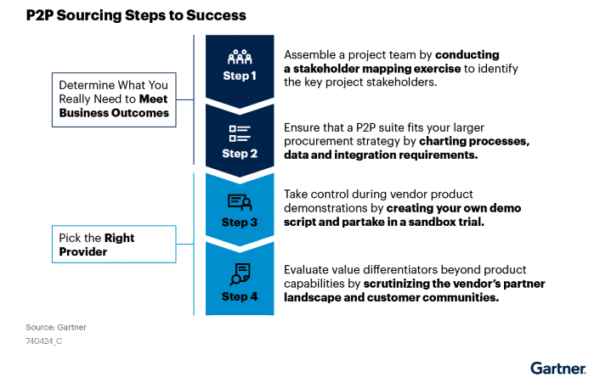
How to Choose Your Best-Fit Procure-to-Pay (P2P) Solution
Deciding on any strategic technology investment can be a daunting task. Procure to pay (P2P) software solutions are often a multiyear commitment, so finding and implementing the best-fit P2P software for your organization can consume a considerable amount of money, time and resources.
Organizations that don’t involve the right stakeholders in the evaluation process often find their projects end up lengthy and over budget. Similarly, if they don’t consider their broader IT and procurement strategy before choosing a procure-to-pay solution, they risk prioritizing features that won’t end up driving value to the business.
By following the steps outlined below, you’ll be able to structure an evaluation process that makes it easy to identify differentiating factors within leading procure-to-pay software and choose the best-fit solution for your organization.

Source: Gartner
Steps for Evaluating Procure-to-Pay Solutions
1. Assemble your A-team: Conduct a Stakeholder Mapping Exercise to Identify your Key Project Stakeholders
Organizations adopt P2P software to help drive savings, process efficiency and contract compliance. Often, this extends to multiple types of end users in different lines of business and locations, and multiple types of spend (i.e., indirect, direct, services). For each layer of complexity in the spend scope, there are additional sets of users and approvers that should be included or consulted in the process to ensure you select the right solution for your needs.
Stakeholder Mapping
To complete your stakeholder map, you need to determine:
- Who in leadership will endorse the project at a high level.
- What functions will be on the periphery of the project and are therefore indirect stakeholders (e.g., supply chain, IT, project managers).
- Who will use the system (e.g., procurement, accounts payable).
- Who the direct stakeholders beyond the users will be (e.g., category managers/procurement, finance team, legal).
If you’re planning to implement an end-to-end solution, ensure your project team is made up of individuals from different functions, geographic areas, and primary user roles. This will help drive insight and alignment throughout the evaluation process and will ultimately help steer you toward your best-fit P2P solution.
RACI Matrix
After identifying key stakeholders, it’s important they understand their role within the lifecycle of the evaluation project. Creating a Responsible, Accountable, Consulted and Informed (RACI) Matrix ensures that every team member is clear on their responsibilities by outlining the various stakeholders along the columns and then outlining the actions that must be taken throughout the course of the project (ex. formalize the budget, confirm critical capabilities, negotiate the proposal, etc.) in the rows. Then, the columns are filled in with the levels of responsibility each stakeholder will take on for each of the stages/actions in the project.
2. Think Big Picture: Ensure that a P2P Solution is Part of your Larger Procurement Strategy
To ensure you’re taking the right approach when evaluating procure-to-pay software and vendors, you should be laser-focused on ensuring the P2P strategy aligns with broader IT and procurement strategies, and that the evaluation process is driven by the use cases and key capabilities you and your team identify and prioritize prior to meeting with vendors.
Align With Strategic Goals
When kicking off a P2P software evaluation, you need to assess the technology through the lens of the broader IT strategy, which may also include considerations such as an overall move to the cloud, incorporation of AI and procurement automation, or commitment to a certain IT standard or architectural approach. This will help you to bridge the gap between finance and business and focus on the strategic value of a vendor’s solution before considering its operational or functional aspects.
The evaluation team should identify and refine the desired business outcomes, challenges and solution needs, and then consult with the stakeholders to prioritize them. This ensures there is clarity around what is a “must have,” what is “strongly desired” and what is “nice to have” before beginning to evaluate vendors.
Identify Key P2P Capabilities and Use Cases
While many procure-to-pay vendors have similar offerings, no single vendor will deliver all capabilities equally across the breadth of your functional, technical and operational requirements. By prioritizing the use cases, requirements, and KPIs you’d like to impact in advance, it’s easier to gain consensus across the team and prevent them from evaluating solutions based on noncritical functions.
The evaluation team should:
- Create a list of detailed requirements (including functional, technical, user experience-related and integration-related) for each critical use case identified.
- Collect any detailed requirements that do not fall neatly under any of the defined critical use cases. This will help differentiate solutions that may have similar capabilities.
- Ensure the critical use cases become the fundamental building blocks of your demo script. Vendors should be able to show you how their solutions satisfy the functional, technical, integration and UX requirements of each use case.
Other things to consider as you put together your evaluation plan include thinking about the support your team may need during and after implementation, understanding how scalable the platform is, and asking for insight into your vendors’ strategic roadmap. This will give you a good idea of what the vendor is trying to achieve in the future and if it will be able to support and expand with your business.
3. Take Control of the Demo Process: Create your own Demo Script to Ensure Vendors are Evaluated Objectively
Once you’ve identified and shortlisted potential P2P vendors, they’ll need to prove their capabilities in a demo and potentially provide a proof of concept via a sandbox environment. Seeing the solution’s features demonstrated live and observing how the vendor delivers the demo is crucial as it can often help you to eliminate at least one of the finalists. This step in the process will be time-consuming, but it shouldn’t be rushed as it will be a major factor in the decision process and the success of the solution you select.
We recommend creating your own vendor demo script that’s based directly on your required use cases prior to receiving any demonstrations. Concentrated and prescribed scripts will help you compare functionality more directly and run a heavily-formulated demo, ensuring vendors do not focus solely on their strengths. It also makes it easier to identify any weaknesses or gaps in their capabilities and ask more pointed questions. In addition, the more that a vendor knows about your needs, the better they will be able to demonstrate how they meet your requirements and improve their pricing. Transparency here is vital for the success of your project.
4. Do your Homework: Scrutinize the Vendor’s Partner Landscape and Customer Communities
The final step is to evaluate the effectiveness of the P2P vendor’s customer community and partner ecosystem. IT leaders often undervalue the importance of this step. Customer communities will help provide examples of best practices and can influence the direction of the vendor’s product based on customer feedback. Partner ecosystems help extend the capabilities of the vendor’s platform. Adding community and ecosystem effectiveness to your procure-to-pay software evaluation process will give you a better view of the complete suite being offered.
Procure to pay software is often a long-term commitment, so it’s critical that you understand your organizational requirements before going to market. Having use cases and critical capabilities clearly scoped out from the beginning will avoid misalignment and drive a more objective evaluation process, allowing you to select the best-fit solution for your organization and drive the savings, process efficiency and contract compliance you’re looking for.
How Procurify can Help
Procurify is a procure-to-pay solution that helps you capture and control your organization’s spending from one unified platform. From request and approval to purchasing, receiving, and paying invoices – our end-to-end workflows make it easy to proactively manage spend so that you can focus on growing your business.
After establishing your team of key stakeholders and outlining your use cases and requirements, reach out and request a demo to explore if we’re the best-fit procure to pay software for your needs!
